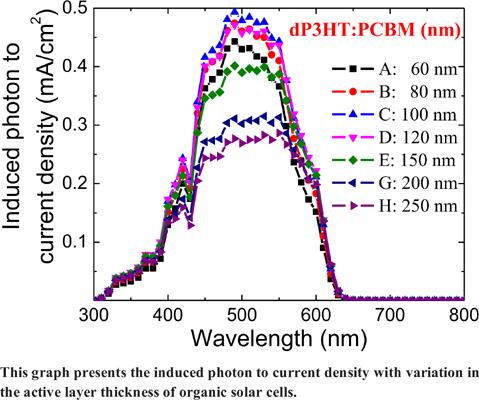Current Nanoscience ( IF 1.5 ) Pub Date : 2020-11-30 , DOI: 10.2174/1573413716666200217103420 Minh Duc Tran 1 , Nguyen Dinh Lam 1

|
Background: The active layer not only must have a strong light absorption in the visible spectrum but must also be sufficient for charge carrier transport to the electrodes. Electrons in conducting polymer transport by hopping between different energy levels resulted in much lower charge mobility. Therefore, the thickness of the active layer must be limited, so the separated charge can reach the corresponding electrodes without recombination. However, a thin active layer has weaker light absorption, resulting in the low photogenerated current in organic solar cell devices. Furthermore, buffer layers usually have high charge mobility, which in turn would enhance the transportation of charge from the active layer to electrodes. Metal oxides have been studied to be used as a cathode buffer layer, such as titanium dioxide (TiO2), zinc oxide (ZnO), etc.
Objective: In this work, behaviors of the photon-electrical characteristics with variation in thickness of the active (poly(3-hexylthiophene-2,5-diyl) and phenyl-C61 butyric acid methyl ester blend) and buffer (zinc oxide) layers were investigated.
Methods: The influences of the thickness of the active and buffer layers on characteristic parameters of organic solar cells were investigated by solving the drift and diffusion equation with the photogenerated current given by the Hetch equation.
Results: The optimum thickness was obtained around 100 nm and below 10 nm for the active and the ZnO buffer layers, respectively.
Conclusion: Thinner active layer resulted in lower photocurrent due to poor light absorption while at 150 nm thick and above, PCE of the device reduced rapidly because of the high recombination rate of photogenerated electron-hole pairs. ZnO buffer layer was used as an electron transport layer and a hole blocking layer in order to improve the cell’s performance. The addition of ZnO enhanced the PCE up to 2.48 times higher than the conventional device.
中文翻译:

有机太阳能电池中活性层和缓冲层特征参数的建模和计算
背景:有源层不仅必须在可见光谱中具有强的光吸收能力,而且还必须足以将电荷载流子传输到电极。通过在不同能级之间跳跃来进行聚合物传输的电子导致了更低的电荷迁移率。因此,必须限制有源层的厚度,以使分离的电荷可以到达相应的电极而不会复合。然而,薄的有源层具有较弱的光吸收,导致有机太阳能电池装置中的光生电流低。此外,缓冲层通常具有高的电荷迁移率,这又将增强电荷从有源层到电极的传输。已经研究了将金属氧化物用作阴极缓冲层,例如二氧化钛(TiO2),氧化锌(ZnO)等
目的:在这项工作中,随着活性层(聚(3-己基噻吩-2,5-二基)和苯基-C61丁酸甲酯混合物)和缓冲层(氧化锌)厚度的变化,光子电特性的行为被调查了。
方法:利用Hetch方程给出的光生电流,通过求解漂移扩散方程,研究了有源层和缓冲层厚度对有机太阳能电池特征参数的影响。
结果:分别获得了有源层和ZnO缓冲层的最佳厚度,分别为100 nm和10 nm以下。
结论:较薄的有源层由于光吸收差而导致较低的光电流,而在150nm以上的厚度下,由于光生电子-空穴对的高重组率,器件的PCE迅速降低。ZnO缓冲层被用作电子传输层和空穴阻挡层,以提高电池的性能。ZnO的添加使PCE比传统器件提高了2.48倍。


























 京公网安备 11010802027423号
京公网安备 11010802027423号